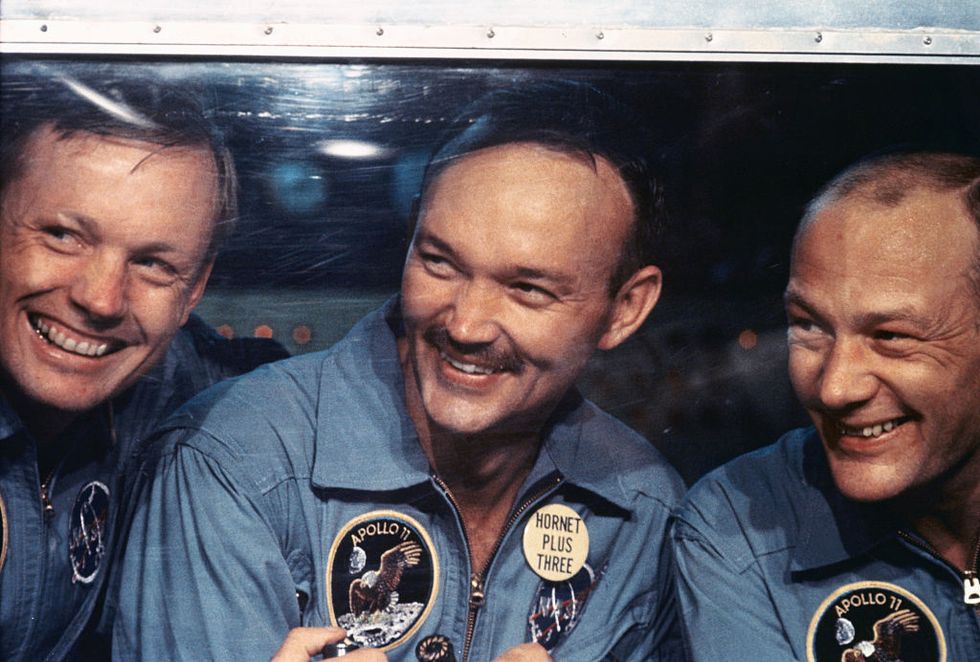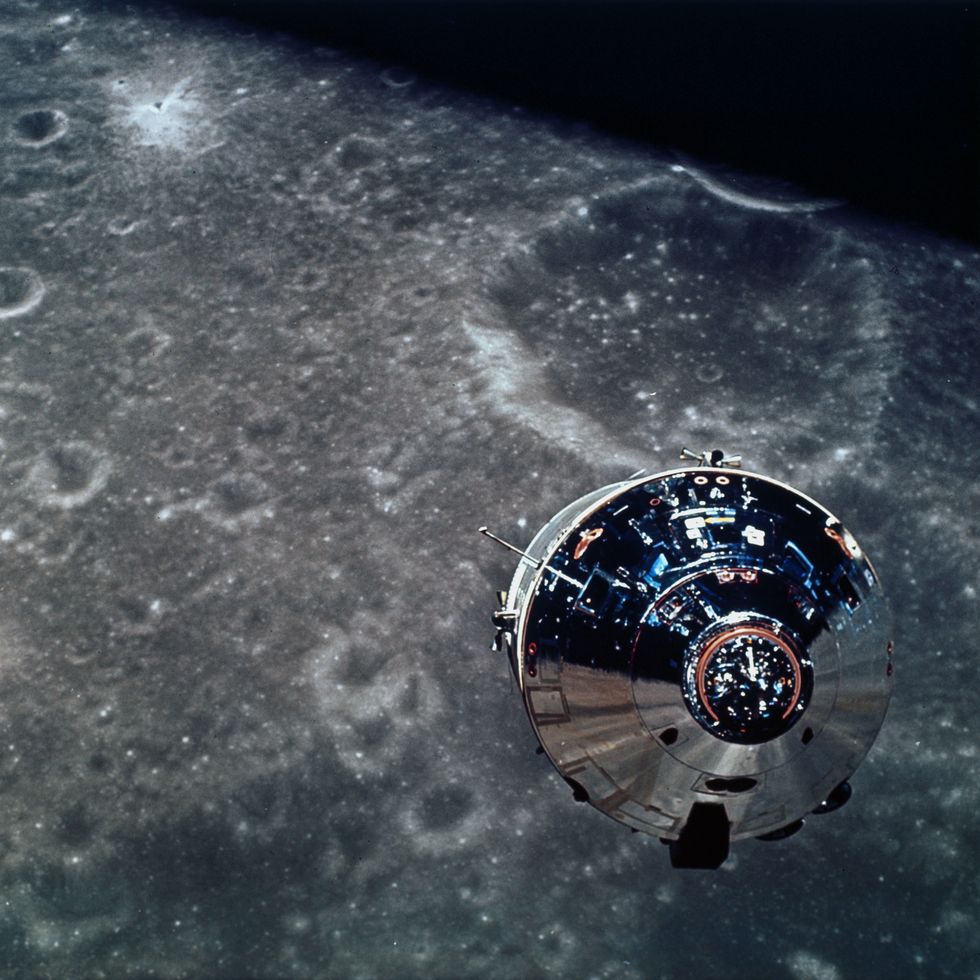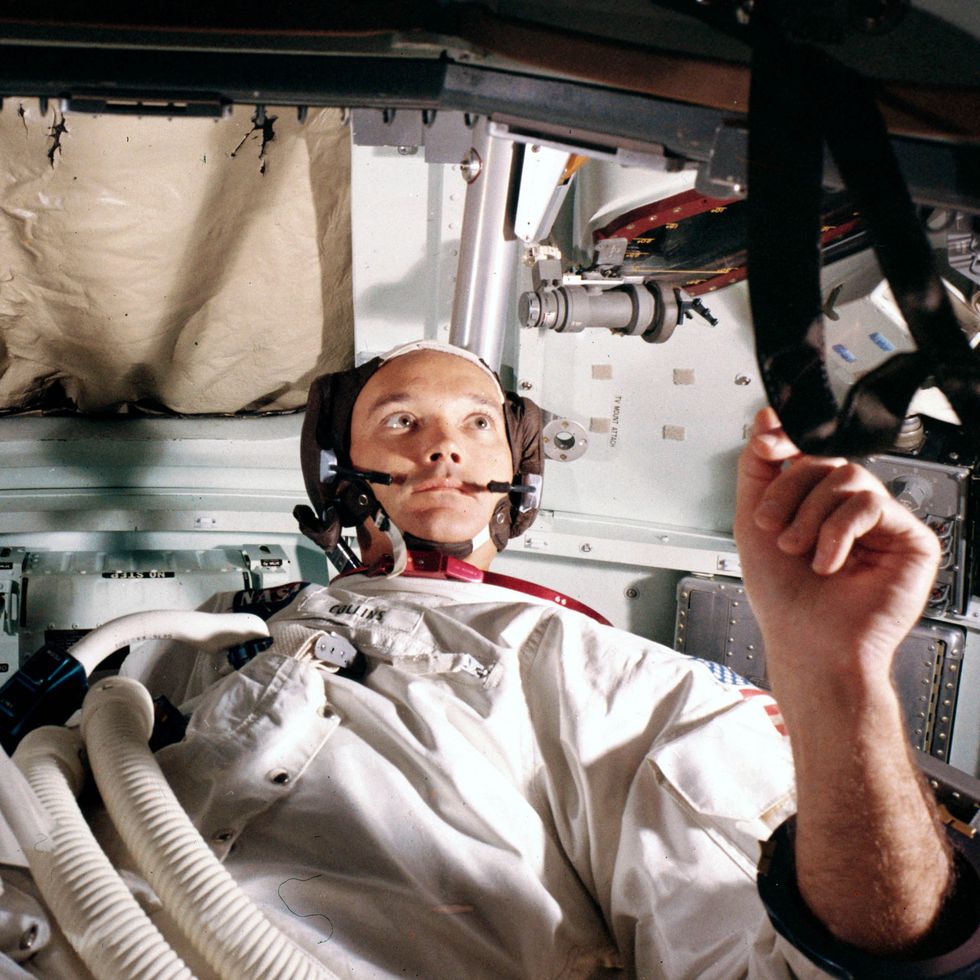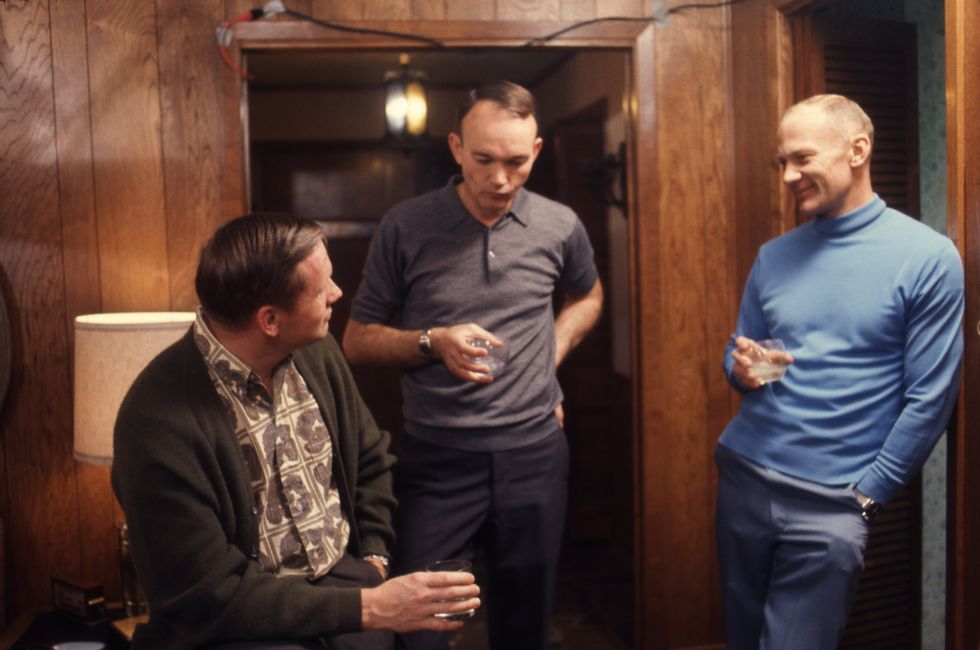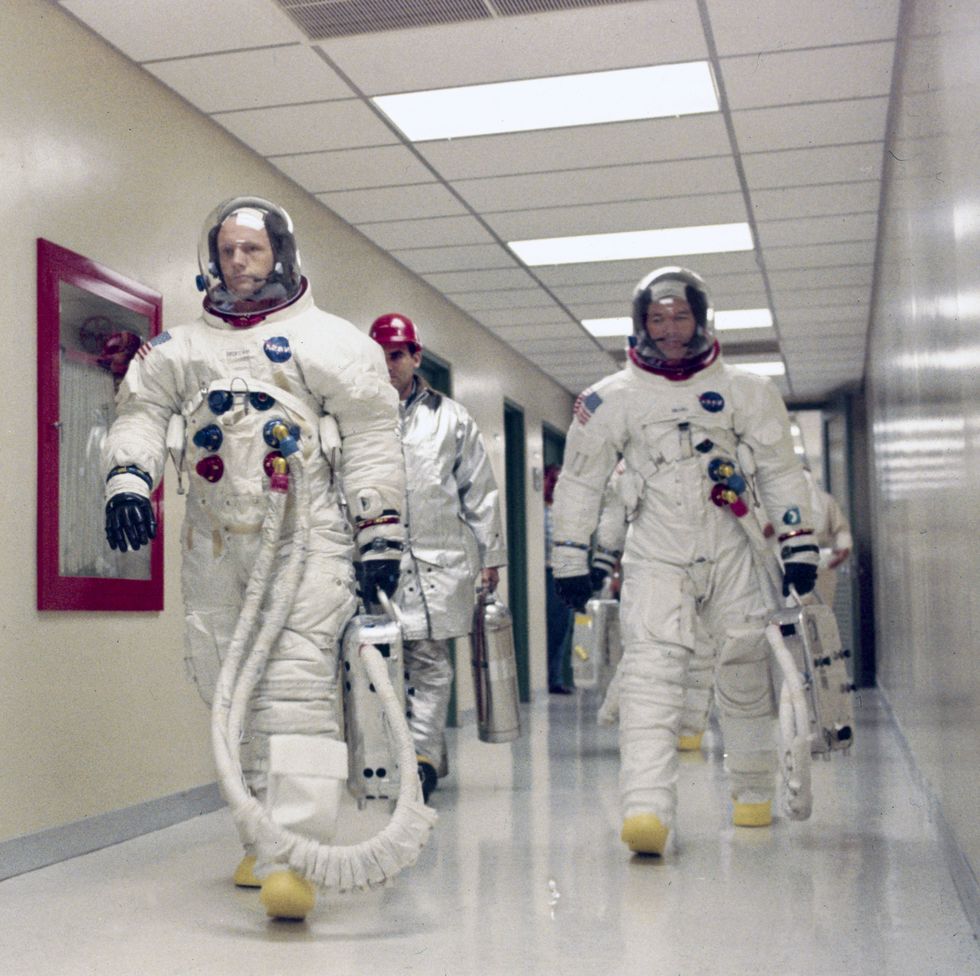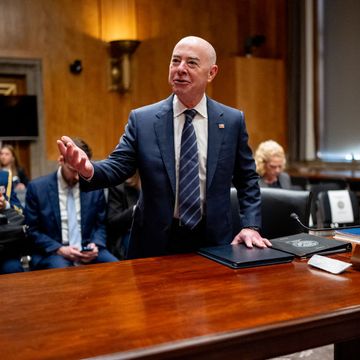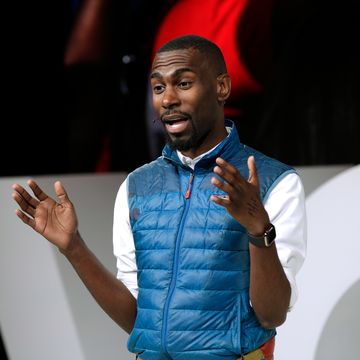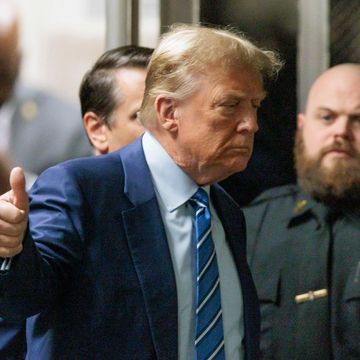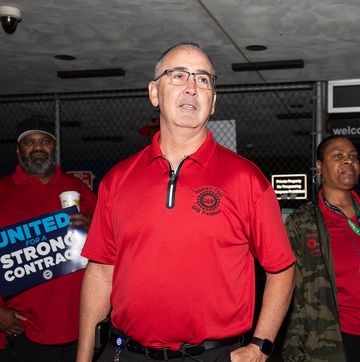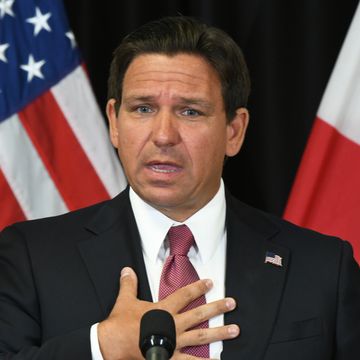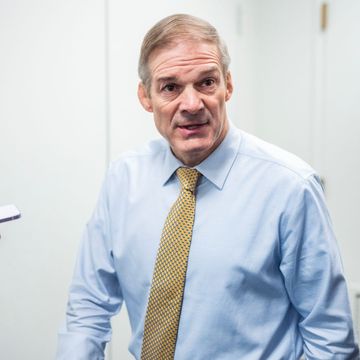On July 20, 1969, at 1:46 p.m., Neil Armstrong and Buzz Aldrin separated the Eagle landing craft from the Apollo 11 command module. Michael Collins stayed behind, firing the rockets, moving about two miles away from his colleagues—and 250,000 miles from humanity on earth. He was absolutely and completely alone.
"Keep talking to me, guys," Collins radioed to the men as he watched their landing craft get smaller and smaller.
At 3:08 p.m., Armstrong and Aldrin, flying feet first, fired the module's descent engine for the first time, preparing to land on the moon. Collins watched as they made their way down to the chalky, grey surface. He radioed to Mission Control the first report of the descent, saying, "Everything's going just swimmingly. Beautiful!"
At 10:56 p.m., Armstrong placed his left foot on the moon, the first human to ever step foot in outerspace. Aldrin snapped photos from the spacecraft, then took his own moon walk. An hour later, the men planted the American flag on the moon’s surface, and Richard Nixon called via Mission Control to say: “Neil and Buzz. I am talking to you from the Oval Room at the White House. And this certainly has to be the most historic telephone call ever made. For every American this has to be the proudest day of our lives.”
While his colleagues talked to the president, Collins sat alone in the command module, circling the moon. When the spacecraft swept behind the moon for 47 minutes at a time, he lost all radio transmissions to and from Mission Control. He was more alone than ever. When Armstrong said the legendary, "That’s one small step for man, one giant leap for mankind,” Collins missed it.
“I am alone now, truly alone, and absolutely isolated from any known life. I am it,” Collins later wrote. “If a count were taken, the score would be three billion plus two over on the other side of the moon, and one plus God knows what on this side.”
A note from the mission log said: "Not since Adam has any human known such solitude as Mike Collins."
In the 50 years since that historic mission, Armstrong and Aldrin have become household names. Collins, who was just as critical to the mission, has avoided the same glare of the spotlight. He’s mostly eschewed media requests over the years, though he’s done a spattering of interviews for the 50th anniversary of the Apollo 11 moon landing, which is this Saturday.
For the last anniversary—the 40th—Collins declined all interviews, instead issuing a statement through NASA, in which he groused about the culture’s obsession with fame and heroism.
“Celebrities? What nonsense, what an empty concept for a person to be, as my friend the great historian Daniel Boorstin put it, 'known for his well-known-ness.' How many live-ins, how many trips to rehab, maybe—wow—you could even get arrested and then you would really be noticed,” he said. “Don't get me started.”
His colleagues Aldrin and Armstrong dealt with the fame in very different ways—but it wreaked havoc on both their lives. Armstrong spent decades desperately avoiding recognition. "Neil was the sort of person that didn't want any of that. He didn't want celebrity. He didn't want the spotlight. He tried everything he could to lead a normal life, short of being a recluse," biographer James Hansen said. Eventually, Armstrong's marriage fell apart. Aldrin, who was more eager to embrace the attention, suffered from depression and alcohol addiction and was twice divorced in the 1970s alone.
Now, with five decades of hindsight, it seems Collins may have, in fact, had the best view of the moon.
Collins, the son of an Army general, joined the U.S. Air Force after graduating from the United States Military Academy at West Point. He went on to become a fighter pilot, then applied to the space program, becoming part of the third class of astronauts in 1963. His first mission was Gemini 10, an Earth-orbiting spacecraft. Apollo 11, bound for the moon, was his second.
In the months before Apollo 11, Collins avoided talking with his wife, Pat, about the very serious danger of the mission. He privately estimated their chance of survival to be 50/50. But Collin’s great fear was that he’d make it out alive—and be the only one to do so.
"My secret terror for the last six months has been leaving them on the Moon and returning to Earth alone," Collins wrote. "If they fail to rise from the surface, or crash back into it, I am not going to commit suicide; I am coming home, forthwith, but I will be a marked man for life and I know it."
When Aldrin and Armstrong made their way back to the command module just after 1 a.m. on July 21st, Collins was so relieved to see his colleagues he considered kissing Aldrin on the forehead. “I decided maybe no, no, I think the history books wouldn’t like that,” Collins told Time.
An estimated 125 to 150 million Americans watched the moon landing on July 20. And on July 24, all three men returned to Earth with a hero’s welcome.
“When we got back from the Moon, none of us was prepared for the adulation that followed,” Aldrin later said. “We were engineers, scientists, fighter pilots being feted like movie stars, and it was all too much for most of us—certainly for me.”
Aldrin battled depression and alcohol addiction after his return from space. In the 1970s, he went through two divorces, lost his fortune, and ended up working at a Cadillac dealership in Beverly Hills. He eventually embraced his role in pop culture, making appearances on The Big Bang Theory and Dancing With the Stars.
Armstrong never warmed to his fame. He retired from NASA a year after Apollo 11, and became a professor at the University of Cincinnati. His marriage fell apart after he retreated into work following the death of his young daughter, according to his biographer. He avoided conversations about his time in NASA, according to reports, and was protective over how his likeness was used, becoming irate when a barber saved strands of his hair to sell for thousands of dollars, The Telegraph reported. Armstrong died in 2012 at age 82.
Collins left NASA shortly after Apollo 11 for a political job in D.C. as the Assistant Secretary of State for Public Affairs in 1970. He later became a director and then an under secretary at the Smithsonian Museum, and eventually started his own aerospace consulting firm.
After his return from Apollo 11, one of his most frequent questions was: “God, you got so close to the moon and you didn't land. Doesn't that really bug you?”
"It really does not. I honestly felt really privileged to be on Apollo 11, to have one of those three seats,” Collins said in a NASA oral history. “Did I have the best of the three? No. But was I pleased with the one I had? Yes! And I have no feelings of frustration or rancor or whatever. I'm very, very happy about the whole thing.”
Collins has said he’s gotten “oodles and oodles” of attention for his role in the historic mission. But he hasn’t seemed to face the same crushing weight of household-name recognition Aldrin and Armstrong did. Collins and his wife Pat remained married until her death in 2014, and the couple had three children. In 2009, Collins said he spent his days, “running, biking, swimming, fishing, painting, cooking, reading, worrying about the stock market, searching for a really good bottle of cabernet under ten dollars.”
When he is interviewed, he still speaks passionately about the topic of space—particularly Mars.
“I always used to joke that they sent me to the wrong place. The moon is far less interesting than Mars,” he told Space.com in April. “If I could rewrite history, I'd much prefer to be on the first Mars crew.”
He seems doubtful that Donald Trump will get us there, though. He quipped to CNN earlier this year, "I don't think he's too much aware of Mars. Maybe he doesn't understand that there is a planet Mars."

Kate Storey is the author of White House by the Sea: A Century of the Kennedys at Hyannis Port and the senior features editor at Rolling Stone. She was previously a staff writer at Esquire, where she covered culture and politics, and has written long-form profiles and narrative features for Vanity Fair, Marie Claire, Town & Country, and other publications.
